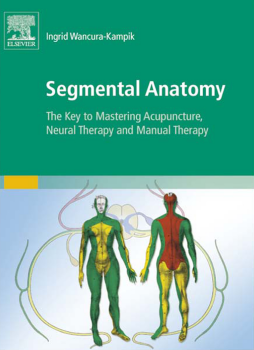
Additional Information
Book Details
Abstract
In Segmental Anatomy the correlations between spinal nerves and segments in skin, musclar system and bones are formidably illustrated and written. The projection areas of internal organs on the body surface area are deduced from the anatomy of the nervous system.
These correlations between spinal nerves and the periphery of the body explain how acupuncture, neural, and manual therapies take effect.
Great accessibility through:
- Full colour images
- Drawings that depict the correlations in detail
- Clearly structured layout facilitating the reading of this complex subject
Table of Contents
| Section Title | Page | Action | Price |
|---|---|---|---|
| Front Cover | Cover | ||
| Segmental Anatomy | III | ||
| Copyright\r | IV | ||
| Foreword | V | ||
| Author’s note to the 1st English edition | VI | ||
| Contents | VII | ||
| KAPITEL 1 - Segmentation and Metamerism | 1 | ||
| What is a Segment? | 1 | ||
| The Significance of Segments | 12 | ||
| KAPITEL 2 - The Role of the Peripheral Spinal Nervous System in Segmentation | 15 | ||
| 2.1 The Spinal Nerve Defines the Segment | 15 | ||
| 2.2 The Spinal Nerves | 17 | ||
| 2.3 The Branches of the Spinal Nerves | 28 | ||
| 2.4 The Branches of the Spinal Nerves in Detail | 44 | ||
| 2.5 The Preaxial and Postaxial Lines, Basis of the Meridian “Lines” | 71 | ||
| KAPITEL 3 - The Role of the Peripheral Autonomic Nervous System in Segmental Theory | 75 | ||
| 3.1 Anatomy | 78 | ||
| 3.2 The Peripheral Sympathetic Nervous System and Its Role in Segmental Theory | 79 | ||
| 3.3 The Peripheral Parasympathetic Nervous System and Its Role in Segmental Theory | 125 | ||
| KAPITEL 4 - The Dermatomes | 127 | ||
| 4.1 Radicular Innervation of the Integument | 127 | ||
| 4.2 Parts of a Dermatome | 138 | ||
| 4.3 The Sensory and Autonomic-Motor Dermatomes | 141 | ||
| 4.4 The Hiatus Lines | 150 | ||
| 4.5 Individual Groups of Dermatomes, and “Autonomic Facial Expression” | 156 | ||
| KAPITEL 5 - The Myotomes | 181 | ||
| 5.1 Radicular Innervation of the Muscles | 181 | ||
| 5.2 Metameric Order of the Myotomes | 183 | ||
| 5.3 Herringham’s Rules of Location and Distribution of Myotomes in the Muscles | 185 | ||
| 5.4 The Muscles of the Upper and Lower Limbs and Their Corresponding Myotomes | 190 | ||
| 5.5 The Individual Myotome Groups | 192 | ||
| KAPITEL 6 - The Sclerotomes | 217 | ||
| 6.1 Radicular Innervation of the Bones | 217 | ||
| 6.2 The Spinal Column and Its Segmental Relations | 219 | ||
| 6.3 The Individual Sclerotomes | 224 | ||
| KAPITEL 7 - The Enterotomes | 239 | ||
| 7.1 Relationships | 239 | ||
| 7.2 “Transformation” of Internal Organs into Enterotomes | 244 | ||
| KAPITEL 8 - Conduction of Impulses between Segments1 | 245 | ||
| 8.1 Multisynaptic, Proprioceptive, and Viscerogenic Reflexes | 245 | ||
| 8.2 Differentiation of Direct, Indirect, and Referred Pains | 249 | ||
| KAPITEL 9 - Referred Pain | 251 | ||
| 9.1 Pain Projected to the Body Surface in Visceral Disease | 251 | ||
| 9.2 Projected Symptoms | 253 | ||
| 9.3 On the Location of Projected Symptoms | 257 | ||
| 9.4 Clinical Significance of Projected Symptoms | 258 | ||
| 9.5 Algetic Symptoms | 259 | ||
| 9.6 Autonomic Reflexive Symptoms | 266 | ||
| KAPITEL 10 - The Visceral Organs – the Enterotomes from the Viewpoint of Segmental Anatomy | 281 | ||
| 10.1 The Heart: Algetic and Autonomic Reflexive Projection Areas | 282 | ||
| 10.2 Lungs and Bronchi: Algetic and Autonomic Reflexive Projection Areas | 294 | ||
| 10.3 The Esophagus: Algetic and Autonomic Reflexive Projection Areas | 303 | ||
| 10.4 Stomach and Duodenum | 306 | ||
| 10.5 Small Intestine (Jejunum, Ileum) | 313 | ||
| 10.6 Cecum, Appendix, Ascending and Transverse Colon | 316 | ||
| 10.7 Descending Colon, Sigmoid Colon, and Rectum | 322 | ||
| 10.8 Kidney, Bladder, Ureter: Algetic and Autonomic Reflexive Projection Areas | 327 | ||
| 10.9 The Genital Tract: Algetic and Autonomic Reflexive Projection Areas | 332 | ||
| 10.10 Testes, Uterus, Ovaries: Algetic and Autonomic Reflexive Projection Areas | 336 | ||
| 10.11 Prostate Gland: Algetic and Autonomic Reflexive Projection Areas | 337 | ||
| 10.12 Liver and Gallbladder: Algetic and Autonomic Reflexive Projection Areas | 339 | ||
| 10.13 Pancreas and Spleen: Algetic and Autonomic Reflexive Projection Areas | 345 | ||
| 10.14 Occurrence of Reflexive and Algetic Symptoms in Other Disorders | 345 | ||
| Bibliography | 347 | ||
| Index\r | 351 |
